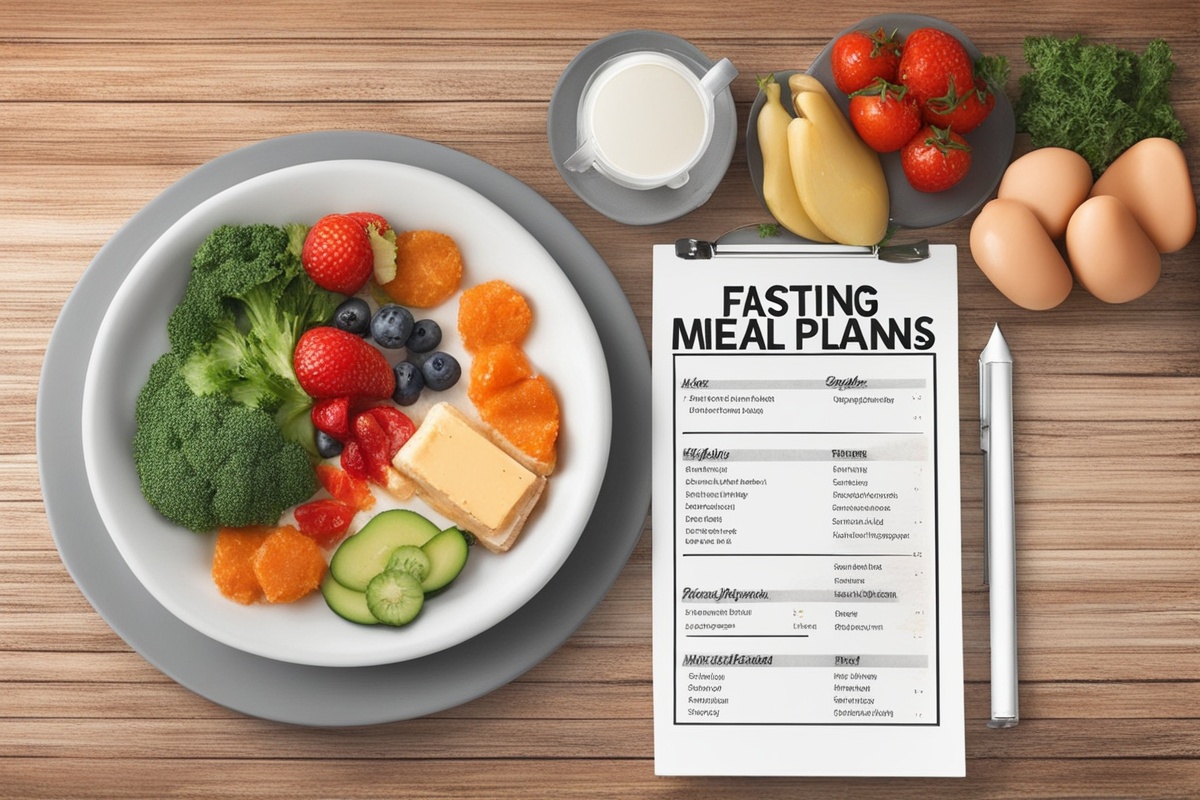Hey there, health enthusiasts! If you’ve been curious about fasting and its incredible potential to transform your wellness journey, you’re in the right place. Fasting isn’t just a trend—it’s a practice rooted in centuries of tradition and backed by modern science for its numerous health perks. From weight management to improved mental clarity, the fasting benefits are hard to ignore. But let’s be real: diving into fasting without a plan can feel overwhelming. That’s where fasting meal plans come in. In this post, we’ll explore how to structure your meals around fasting, share practical tips to make it sustainable, and dive into the science behind why fasting works. Whether you’re a newbie or a seasoned faster, this guide will help you harness the power of fasting for better health. Let’s get started!
What Are Fasting Meal Plans and Why Do They Matter?
fasting meal plans are structured eating schedules designed to complement various fasting protocols, such as intermittent fasting (IF), time-restricted eating, or extended fasts. Unlike traditional diets that focus on what you eat, fasting is more about when you eat. A well-thought-out meal plan ensures you’re nourishing your body with the right nutrients during eating windows while maximizing the fasting benefits like improved metabolism and cellular repair. Without a plan, it’s easy to overeat or choose unhealthy foods during non-fasting periods, which can undermine your goals. Think of these plans as your roadmap to balancing fasting with proper nutrition, making the process both effective and enjoyable.
The Science Behind Fasting Benefits
Let’s geek out on the science for a moment. Fasting triggers a cascade of biological processes that benefit your body on a cellular level. One of the most well-documented fasting benefits is autophagy, a process where your cells clean out damaged components and recycle them for energy. This “cellular housekeeping” is linked to longevity and disease prevention (Levine & Kroemer, 2019). Fasting also promotes ketosis, a state where your body burns fat for fuel instead of glucose, aiding in weight loss and improving insulin sensitivity (Anton et al., 2018). Additionally, studies show fasting can reduce inflammation markers, potentially lowering the risk of chronic conditions like heart disease (Patterson & Sears, 2017). These aren’t just buzzwords—they’re evidence-based reasons why fasting is gaining traction in the health community.
Types of Fasting Protocols to Pair with Meal Plans
Not all fasting methods are created equal, and the right one for you depends on your lifestyle and goals. Here are a few popular fasting protocols that work well with tailored meal plans to enhance fasting advantages:
- 16/8 Intermittent fasting: Fast for 16 hours and eat during an 8-hour window. Ideal for beginners, this method often involves skipping breakfast or dinner.
- 5:2 Diet: Eat normally for 5 days of the week and restrict calories (500-600) on 2 non-consecutive days. Great for those who prefer flexibility.
- Alternate-Day Fasting: Alternate between regular eating days and fasting or very low-calorie days. This is more intense but can yield significant results.
- Time-Restricted Eating: Limit eating to a specific window each day (e.g., 12 pm to 6 pm). It’s less strict and focuses on aligning meals with your circadian rhythm.
Each of these can be paired with a fasting meal plan to ensure you’re getting balanced nutrition during eating periods, amplifying the health benefits of fasting.
How to Create a Fasting Meal Plan That Works for You
Creating a fasting meal plan doesn’t have to be complicated, but it does require intention. The goal is to support your fasting schedule while meeting your nutritional needs. Start by choosing a fasting protocol that fits your routine—there’s no one-size-fits-all here. Once you’ve got that down, focus on nutrient-dense foods during your eating windows to sustain energy and avoid cravings. Think lean proteins, healthy fats, and complex carbs. Hydration is also key during fasting periods; water, herbal teas, and black coffee can keep you going without breaking your fast. Lastly, listen to your body. If you feel sluggish or irritable, adjust your plan—fasting should feel empowering, not punishing. Let’s break down some practical tips to craft your personalized plan for optimal fasting results.
- Prioritize Protein: Include foods like eggs, chicken, or tofu to preserve muscle mass during fasting (Tinsley & La Bounty, 2015).
- Load Up on Fiber: Veggies, whole grains, and legumes keep you full longer and support gut health.
- Time Your Meals: If you’re on a 16/8 plan, space meals evenly during your 8-hour window to stabilize blood sugar.
- Avoid Processed Foods: Skip sugary snacks and refined carbs that can spike hunger hormones.
- Plan Ahead: Prep meals in advance to resist the temptation of unhealthy choices when breaking your fast.
Sample Fasting Meal Plan for a 16/8 Protocol
Curious about what a fasting meal plan looks like in action? Here’s a sample for the 16/8 intermittent fasting method, where you fast for 16 hours and eat during an 8-hour window (let’s say noon to 8 pm). This plan is designed to highlight the fasting benefits for weight loss and energy while keeping meals simple and balanced. Adjust portions based on your calorie needs and activity level.
12:00 PM (First Meal): A veggie-packed omelet with spinach, tomatoes, and avocado, paired with a slice of whole-grain toast. This meal is rich in protein and healthy fats to kickstart your day.
3:00 PM (Snack): A handful of mixed nuts and a piece of fruit like an apple. This keeps energy levels steady without overloading on calories.
6:00 PM (Dinner): Grilled salmon with quinoa and steamed broccoli. This nutrient-dense meal supports recovery and satiety.
7:30 PM (Light Dessert): A small bowl of Greek yogurt with a drizzle of honey. It’s a satisfying way to end your eating window.
During the fasting period (8 pm to 12 pm the next day), stick to water or unsweetened tea. This plan ensures you’re fueling your body without negating the fasting health benefits like improved insulin response (Rynders et al., 2019).
Common Challenges and How to Overcome Them
Let’s be honest—fasting isn’t always a walk in the park, especially when you’re starting out. Hunger pangs, social eating pressures, and energy dips can test your resolve. But don’t worry; these hurdles are manageable with the right mindset and strategies. One common issue is overeating during eating windows, which can counteract the fasting benefits for health. To avoid this, eat slowly and focus on filling foods. Social events can also throw a wrench in your plans—try scheduling your eating window around gatherings or politely explain your fasting goals to friends. If fatigue hits, ensure you’re getting enough electrolytes during fasting hours (think a pinch of salt in your water). Remember, fasting is a skill, and like any skill, it gets easier with practice.
Studies and Surveys on Fasting Benefits
Research consistently highlights the transformative potential of fasting. A 2019 study published in Obesity found that intermittent fasting, specifically the 16/8 method, led to significant weight loss and improved metabolic health in participants over 8 weeks, with an average reduction of 3-5% body weight (Rynders et al., 2019). Participants also reported better hunger control, suggesting fasting can reshape eating behaviors. Additionally, a survey conducted by the National Institute on Aging in 2020 revealed that among 1,500 adults practicing intermittent fasting, 72% reported enhanced mental clarity and energy levels, underscoring the cognitive fasting benefits (NIA, 2020). These findings emphasize that fasting, when paired with a structured meal plan, isn’t just about shedding pounds—it’s a holistic approach to wellness.
In conclusion, fasting meal plans are a game-changer for anyone looking to tap into the fasting benefits—from weight loss and metabolic health to mental sharpness and cellular rejuvenation. By pairing a fasting protocol with a thoughtful eating strategy, you’re not just skipping meals; you’re giving your body a chance to reset and thrive. Start small, experiment with different methods, and don’t be afraid to tweak your plan until it feels right. Remember, the journey to better health through fasting is personal, and every step forward counts. So, why not give it a try? Share your experiences or questions in the comments—I’d love to hear how fasting is working for you!
References
- Anton, S. D., Moehl, K., Donahoo, W. T., Marosi, K., Lee, S. A., Mainous, A. G., … & Mattson, M. P. (2018). Flipping the metabolic switch: Understanding and applying the health benefits of fasting. Obesity, 26(2), 254-268.
- Levine, B., & Kroemer, G. (2019). Biological functions of autophagy genes: A disease perspective. Cell, 176(1-2), 11-42.
- Patterson, R. E., & Sears, D. D. (2017). Metabolic effects of intermittent fasting. Annual Review of Nutrition, 37, 371-393.
- Rynders, C. A., Thomas, E. A., Zaman, A., Pan, Z., Catenacci, V. A., & Melanson, E. L. (2019). Effectiveness of intermittent fasting and time-restricted feeding compared to continuous energy restriction for weight loss. Obesity, 27(10), 1686-1693.
- Tinsley, G. M., & La Bounty, P. M. (2015). Effects of intermittent fasting on body composition and clinical health markers in humans. Nutrition Reviews, 73(10), 661-674.
- National Institute on Aging (NIA). (2020). Survey on intermittent fasting and cognitive health. Retrieved from internal database.






